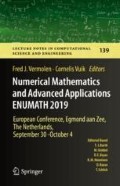Abstract
This paper focus on a finite element approximation of aeroelastic problems. The turbulent flow interacting with flexibly supported airfoil is considered. The flow is described by unsteady Reynolds averaged Navier–Stokes equations, where the main attention is paid to the simulation of turbulent flow with the transition. The motion of the computational domain is addressed and the coupled aeroelastic problem is discretized. Numerical results are shown.
Access this chapter
Tax calculation will be finalised at checkout
Purchases are for personal use only
References
P. Sváček, J. Horáček, Numerical simulation of aeroelastic response of an airfoil in flow with laminar-turbulence transition, Applied Mathematics and Computation 267 (2015) 28–41.
O. Winter, Sváček, On numerical simulation of flexibly supported airfoil in interaction with incompressible fluid flow using laminar-turbulence transition model, Computers & Mathematics with Applications(in press) (2020). https://doi.org/10.1016/j.camwa.2019.12.022. https://www.sciencedirect.com/science/article/pii/S0898122119305966.
Y. C. Fung, An Introduction to the Theory of Aeroelasticity, Courier Dover Publications, 2008.
M. Feistauer, J. Horáček, M. R˚užička, P. Sváček, Numerical analysis of flow-induced nonlinear vibrations of an airfoil with three degrees of freedom, Computers & Fluids 49 (1) (2011) 110–127. https://doi.org/10.1016/j.compfluid.2011.05.004.
P. Sváček, M. Feistauer, J. Horáček, Numerical simulation of flow induced airfoil vibrations with large amplitudes, Journal of Fluids and Structures 23 (3) (2007) 391–411.
S. B. Pope, Turbulent Flows, Cambridge University Press, Cambridge, 2000.
F. Nobile, Numerical approximation of fluid-structure interaction problems with application to haemodynamics, Ph.D. thesis, Ecole Polytechnique Federale de Lausanne (2001).
F. R. Menter, Two-equations eddy-viscosity turbulence models for engineering applications, AIAA Journal 32 (8) (1994) 1598–1605.
F. Menter, R. Langtry, S. Völker, Transition modelling for general purpose CFD codes, Flow, Turbulence and Combustion 77 (1-4) (2006) 277–303.
J. C. Kok, Resolving the dependence on free-stream values for the k-omega turbulence model, Tech. rep., National Aerospace Laboratory NLR (1999).
D. C. Wilcox, Turbulence Modeling for CFD, DCW Industries, 1993.
R. B. Langtry, F. R. Menter, Correlation-based transition modeling for unstructured parallelized computational fluid dynamics codes, AIAA Journal 47 (12) (2009) 2894–2906.
R. Codina, A discontinuity capturing crosswind-dissipation for the finite element solution of the convection diffusion equation, Computational Methods in Applied Mechanical Engineering 110 (1993) 325–342.
G. Lube, G. Rapin, Residual-based stabilized higher-order FEM for advection-dominated problems, Computer Methods in Applied Mechanics and Engineering 195 (33-36) (2006) 4124–4138.
R. Codina, Stabilization of incompressibility and convection through orthogonal sub-scales in finite element methods, Computational Method in Applied Mechanical Engineering 190 (2000) 1579–1599.
P. Sváček, On implementation aspects of finite element method and its application, Advances in Computational Mathematics 45 (4) (2019) 2065–2081.
Acknowledgements
Authors acknowledge support from the EU Operational Programme Research, Development and Education, and from the Center of Advanced Aerospace Technology (CZ.02.1.01/0.0/0.0/16_019/0000826), Faculty of Mechanical Engineering, Czech Technical University in Prague.
Author information
Authors and Affiliations
Corresponding author
Editor information
Editors and Affiliations
Rights and permissions
Copyright information
© 2021 Springer Nature Switzerland AG
About this paper
Cite this paper
Sváček, P. (2021). On Finite Element Approximation of Aeroelastic Problems with Consideration of Laminar-Turbulence Transition. In: Vermolen, F.J., Vuik, C. (eds) Numerical Mathematics and Advanced Applications ENUMATH 2019. Lecture Notes in Computational Science and Engineering, vol 139. Springer, Cham. https://doi.org/10.1007/978-3-030-55874-1_94
Download citation
DOI: https://doi.org/10.1007/978-3-030-55874-1_94
Published:
Publisher Name: Springer, Cham
Print ISBN: 978-3-030-55873-4
Online ISBN: 978-3-030-55874-1
eBook Packages: Mathematics and StatisticsMathematics and Statistics (R0)

